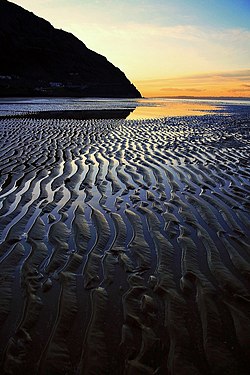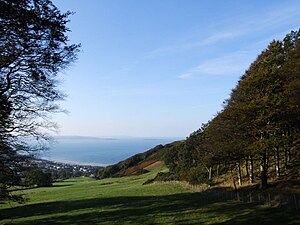Penmaenmawr
| Penmaenmawr | |
| Caernarfonshire | |
|---|---|
 Penmaenmawr beach | |
| Location | |
| Grid reference: | SH718762 |
| Location: | 53°16’5"N, 3°55’24"W |
| Data | |
| Population: | 3,857 (2001) |
| Postcode: | LL34 |
| Dialling code: | 01492 |
| Local Government | |
| Council: | Conwy |
Penmaenmawr is a coastal town in Caernarfonshire, on the seacoast between Conwy and Llanfairfechan. It is a quarrying town, though the latter is no longer a major employer.
The population was recoreded as 3,857 in 2001.
The town was bypassed by the A55 road in the 1980s, losing its old Edwardian period promenade in the process, which was largely replaced by a modern one. Penmaenmawr is known for its spectacular mountain walks and coastal walks.
Nearby are the popular attractions of the Sychnant Pass and Mynydd y Dref. The town also lies partly within the Snowdonia National Park.
Name of the village
The name Penmaenmawr translates loosely as the Welsh pen maen mawr, meaning for "Head of the Great Stone" though in this case it might be rendered more accurately as "Greater Stonehead", after one of the headlands, Penmaen Mawr, protecting the bay. The name is Victorian, as the town was created out of four villages: Penmaenan and Pant Yr Afon on the west and Dwygyfylchi and Capelulo on the east.
Geography

The villages that make up Penmaenmawr are Penmaenan and Pant Yr Afon on the west and Dwygyfylchi and Capelulo on the east. They lay on a small coastal plain about 2 miles in length and half a mile deep facing Conwy Bay and the Irish Sea to the north.
The bay is sheltered by the south-east tip of Anglesey and Puffin Island to the north-west and the limestone headland of the Great Orme to the north-east. The sea is shallow here between Traeth Lafan and the Conwy estuary. The beach is extensive, (awarded a Blue Flag for 5 years running) consisting of smooth pebbles and a wide expanse of sand.
Two impressive headlands separate Penmaenmawr from its neighbours. In the west the huge bulk of Penmaen Mawr lies between the town neighbouring Llanfairfechan and the wider coastal plain extending to Bangor. To the east the smaller but no less rugged headland of Penmaen Bach divides Dwygyfylchi from Conwy Morfa.
Penmaenbach is the most northerly tip of the Snowdonia National Park, and the Park covers a large part of Dwygyfylchi and Capelulo.
To the south an arc of hills and uplands extends east to west from the latter to Penmaen Mawr, beginning with Yr Allt Wen above Dwygyfylchi, Bwlch Sychnant (the old road crosses this pass to Conwy) & Pen-sychnant at Capelulo. The rounded hill of Foel Lys, Gwddw Glas (Green Gorge), Bryn Derwydd and the head of Cwm Graiglwyd and finally Penmaen-mawr itself.
The coastal plain itself is nearly divided by Trwyn-yr-Wylfa, which also marks the boundary between Pant-yr-afon and Penmaenan in the west and the "Hen Bentra" or "Old Village" of Dwygyfylchi and Capelulo in the east.
Finally two small rivers flow through the area. The first, the Pabwyr, runs down from wooded Cwm Graiglwyd then under the town centre, Pant-yr-afon, to the beach; the second and larger, the Gyrrach, runs for about 4 miles from the northern slopes of Tal-y-Fan to the sea near Penmaenbach, passing through Nant Ddaear-y-llwynog (The Fairy Glen) and the old villages of Dwygyfylchi and Capelulo.
History

Prehistory
The uplands above the town have a wealth of prehistoric remains, including the site of prehistoric polished stone axe factories on the western slopes of Cwm Graiglwyd near the top of Penmaen-mawr. This was once one of the most important stone axe manufacturing sites found in Europe, along with those in upper Great Langdale in Westmorland, Tievebulliagh in County Antrim and other sites across Britain. The Langdale axe industry has been well studied in recent years; that of Cwm Graiglwyd less so as yet. There is evidence that axes from Graiglwyd were exported widely 5,000 years ago, examples having been found as far afield as Cornwall and south-east England.
The nearby Druid's Circle (Welsh: Meini Hirion) is a prehistoric stone circle, one of the finest in Wales. A prehistoric trackway from Bwlch-y-ddeufaen to Conwy runs by the circle. The summit of Penmaen-mawr, from which the town takes its name, was 1,500 feet above sea level until reduced by modern quarrying. The summit area was crowned by Braich-y-Dinas, one of the largest Iron Age hill-forts in Wales and indeed Europe, comparable with Tre'r Ceiri near Trefor on the Llŷn peninsula; unfortunately nothing remains today, the last remnants' having been obliterated in the 1920s.
Mediæval and Early Modern Period

According to tradition, the 5th or 6th century saint Seiriol, after whom Ynys Seiriol (also known as Puffin Island or Priestholme) is named, had a hermit's cell in Cwm Graiglwyd. A declivity, Clipyn Seiriol, above the modern road tunnel through Penmaen-mawr, also bears his name, as does the modern church of St Seiriol's near the town centre. Seiriol was a son of Helig ap Glannog, a prince who is said to have lived at Llys Helig, now covered by the sea, and which has given rise to the legend of the drowned palace. The older church of St Gwynin's in Dwygyfylchi is the parish church today. Penmaenmawr is also associated with Saint Ulo, Capelulo being at the foot of Sychnant and reputedly the site of an early mediæval chapel.
From the early Middle Ages onwards the parish has been part of Arllechwedd Uchaf, and this ancient Welsh commote, which together with neighbouring Arllechwedd Isaf makes up the cantref (hundred) of Arllechwedd, is still used by the church as an administrative unit today.
Quarrying Town and Seaside Resort
The industrial quarrying of granite at Penmaenan began in the early 19th century with the forming of the Penmaenmawr & Welsh Granite Co..
As the industry grew workers and their families flocked to Penmaenmawr from all over north-west Wales and beyond. The link was especially strong with Trefor, also the home of a significant granite quarry on the slopes of Yr Eifl. The community which sprang up in the present day wards of Penmaenan and Pant-yr-afon was close-knit and almost entirely Welsh-speaking. By the early years of the 20th century about 1,000 men worked in the quarry and its associated workshops. Neighbouring Llanfairfechan was an integral part of this process.
The granite was lowered from the quarry by self-acting inclines to the 3-foot gauge tramway which ran to jetties from where the setts were loaded into ships. After 1848 the majority of the quarry output was sent by main-line rail, although the quarry and its internal narrow gauge railway continued to thrive through the nineteenth century.
Life was far from easy for the quarrymen, especially those who worked on the higher slopes. They were expected to walk up to the summit area in all weather and faced losing pay if unable to reach the top. Naturally a strong spirit of camaraderie developed and this was reflected in the town's chapels, pubs and cultural societies. Granite was exported by rail to ports like Liverpool and the cities of England and by sea from the two quarrying jetties to Liverpool and also to a number of European ports such as Hamburg.
The town grew in popularity as a seaside resort for the well-to-do in the second half of the 19th century, in part due to the enthusiasm shown by statesman and Prime Minister William Ewart Gladstone who holidayed 11 times in Penmaenmawr between 1855 and 1896. [1]
The Red Gables massacre
On the 24th September 1976, peaceful Penmaenmawr was the scene of a mass murder, as former Submarine Commander Neil Rutherford DSC and Bar killed four people at the Red Gables hotel, then set the hotel on fire and shot himself.[1]
Round and about
- Amgueddfa Bythynod New York Cottages Museum: Concentrating on the history of the quarry and the community which flourished around it. These early cottages built to house quarrymen are on Ffordd Bangor (Bangor Road).
- Eden Hall: Small but historic gardens near the town centre.
- Pen Sychnant Nature Reserve - Located at the top of the Sychnant Pass, Dwygyfylchi. Conservation area of 12 acres with mature shrubs & woodland. Local wildlife Artists exhibit.
Big society
- Clwb Golff Penmaenmawr Golf Club: A 9 hole course on Hen Ffordd Conwy (Old Conwy Road) in Dwygyfylchi, one of the most scenic in north Wales.
- Penmaenmawr Sailing Club - Located on Penmaenmawr Promenade.
- Penmaenmawr Bowling Club - Located opposite the promenade entrance near the railway station.
- Dwygyfylchi Bowling Club - Located either on foot from Treforris Road, Dwygyfylchi or via the Penmaenmawr Golf Club on Conwy Old Road, Dwygyfylchi.
- Penmaenmawr Phoenix FC - The town's football team, composed mainly of local players. Currently playing in the Clwyd Premier league.
- Clwb Snwcer Penmaenmawr Snooker Club - Located within the Community Centre on Ffordd Conwy (Conwy Road) and boasts 4 tables with teams competing in three different leagues.
Events
- Penfest: An all day outdoor music festival held annually on the last Saturday of July, featuring bands from the North Wales coast and beyond.
Outside links
- Penmaenmawr and Dwygyfylchi Community Website
- Visit the Sychnant Pass
- Penmaenmawr Community Centre
- Penmaenmawr Golf Club
- Penmaenmawr Sailing Club
- Clwyd Football League
- Geograph.co.uk photos of Penmaenmawr and surrounding area
References
- ↑ North Wales Weekly News, 30th September 1976